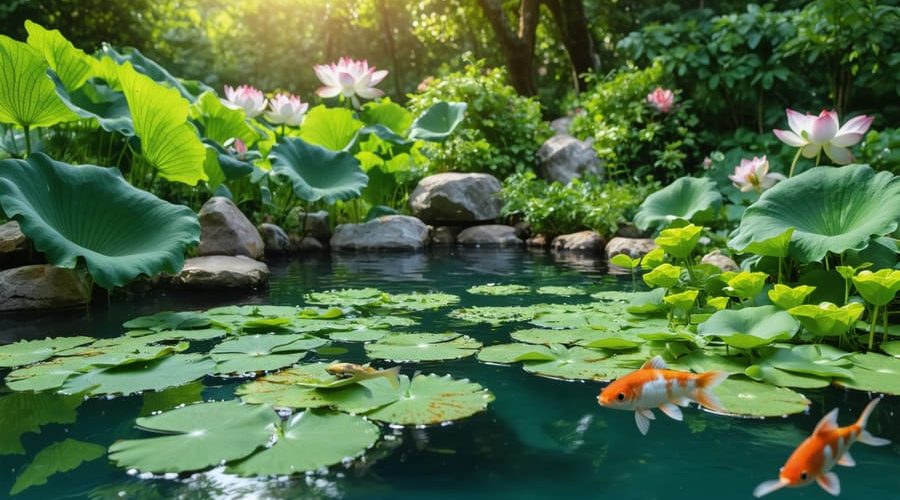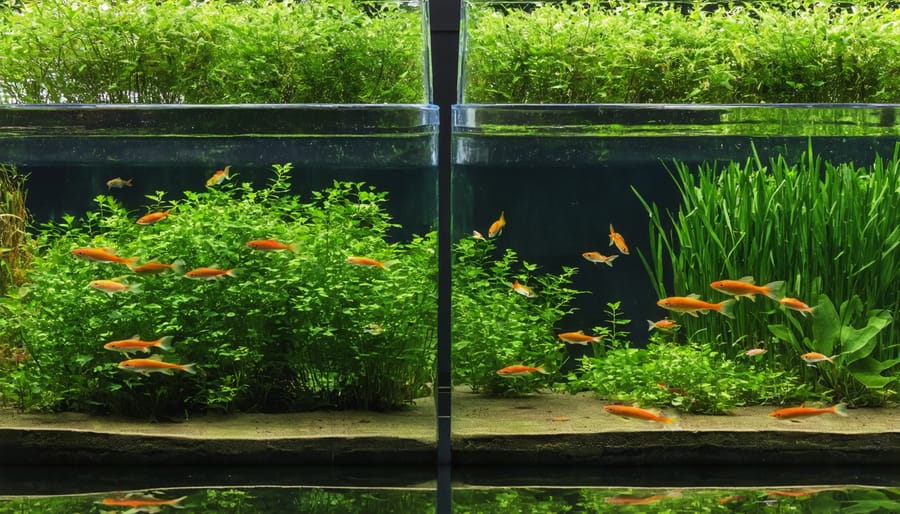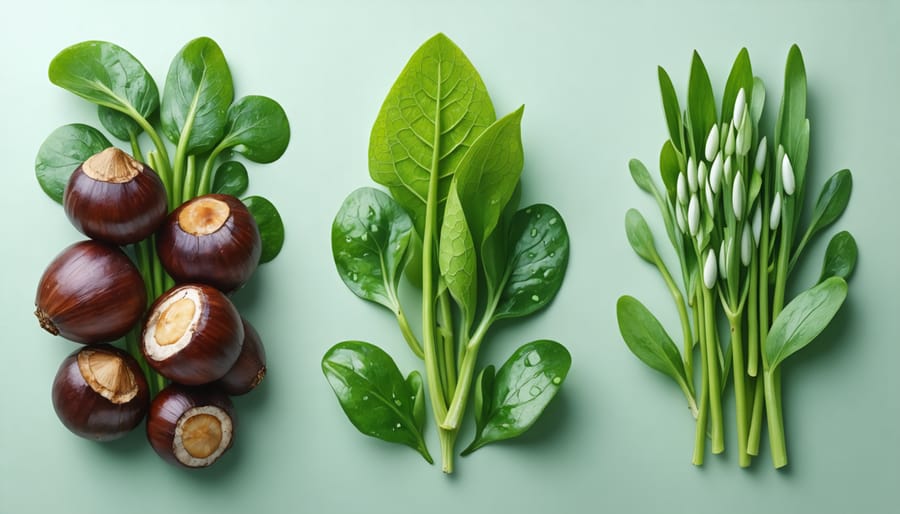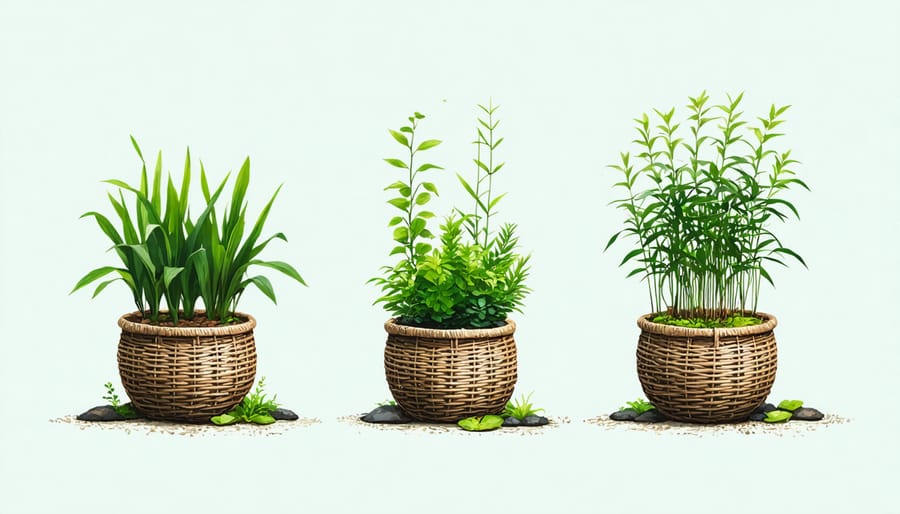
Boost Your Fish Pond’s Health with These Beautiful Edible Plants
Transform your backyard pond into a thriving aquatic garden that not only looks beautiful but provides fresh, nutritious food for your table. Edible aquatic plants like watercress, water chestnuts, and lotus create a sustainable ecosystem while offering a unique culinary experience right at home. These versatile plants serve multiple purposes – they naturally filter water, provide shelter for fish, and produce delicious, nutrient-rich harvests throughout the growing season.
From the crisp, peppery taste of fresh watercress in salads to the sweet, starchy water chestnuts perfect for stir-fries, aquatic edibles offer flavors and textures you can’t find in traditional gardens. Many of these plants are surprisingly easy to grow, requiring minimal maintenance once established, and they can thrive in various water depths and conditions. Whether you’re a seasoned water gardener or just starting your aquatic adventure, incorporating edible plants into your pond creates a productive, eco-friendly water feature that connects you to ancient food-growing traditions while providing sustainable, home-grown ingredients for your kitchen.
Why Edible Plants are Perfect for Your Fish Pond

Natural Filtration Benefits
Edible aquatic plants do more than just provide a sustainable food source – they’re natural powerhouses when it comes to maintaining water quality in your pond. Through a process of natural filtration and oxygenation, these plants help create a balanced ecosystem that benefits both plants and fish.
As these plants absorb nutrients for growth, they naturally remove excess nitrogen and phosphorus from the water – the same compounds that can lead to algae blooms. Water chestnuts, for example, are particularly effective at absorbing nitrates, while watercress helps reduce ammonia levels. Their root systems also trap suspended particles, keeping your pond water clearer.
Many edible aquatics, like water spinach and lotus, have extensive root networks that provide shelter for beneficial bacteria. These microscopic helpers break down organic waste and further improve water quality. As an added bonus, the shade created by floating leaves helps regulate water temperature and reduces algae growth, creating a healthier environment for your fish and other aquatic life.
Fish Health and Habitat
Aquatic plants play a crucial role in creating a balanced pond ecosystem that supports healthy fish populations. These plants naturally filter water by absorbing excess nutrients and providing oxygen through photosynthesis. They offer essential shelter for fish to hide from predators and create perfect spawning areas for breeding.
Many edible aquatic plants, like watercress and water chestnuts, also help regulate water temperature by providing shade, which is especially important during hot summer months. The plants’ root systems trap sediment and help maintain water clarity, while also hosting beneficial microorganisms that break down fish waste.
For your fish friends, these plants serve as natural snacking stations – many fish love nibbling on tender plant parts and finding tiny insects that make their homes among the foliage. When planning your edible water garden, consider including a mix of floating, submerged, and marginal plants to create different layers of habitat. This diversity not only benefits your fish but also ensures a more stable and self-sustaining environment where both plants and fish can thrive together.

Top Edible Aquatic Plants for Your Pond
Water Chestnuts
Water chestnuts are fascinating aquatic vegetables that grow in shallow, muddy waters. Despite their name, they’re not actually nuts but rather the corm (underground stem) of a grass-like sedge plant. Growing water chestnuts at home can be a rewarding experience, yielding crispy, sweet-tasting crops perfect for both Asian cuisine and fresh snacking.
To grow water chestnuts successfully, start by planting them in spring when temperatures consistently stay above 50°F (10°C). You’ll need containers at least 12 inches deep filled with rich, heavy soil. Plant the corms about 4 inches apart and cover them with 2-3 inches of water. Maintain water depth throughout the growing season and fertilize monthly with an aquatic plant fertilizer.
Water chestnuts take about seven months to mature. You’ll know they’re ready to harvest when the leaves begin to yellow and die back in late fall. To harvest, simply drain the water and carefully dig up the corms. Each plant typically produces 3-5 new corms, which are about the size of golf balls when mature.
Store fresh water chestnuts in the refrigerator, where they’ll keep for up to two weeks. For longer storage, you can freeze them after peeling. Remember to save some corms for next season’s planting. The best part about growing water chestnuts is that they not only provide tasty additions to your meals but also help maintain water quality in your pond by absorbing excess nutrients.
Watercress
Watercress is one of the most nutritious aquatic plants you can grow in your pond or water garden. This peppery-flavored green thrives in moving water and is packed with vitamins A, C, and K, making it a superfood that’s easy to cultivate at home.
To grow watercress successfully, you’ll want to maintain water temperatures between 50-60°F (10-15°C). The plant does best in shallow water about 3-6 inches deep, with a steady flow that prevents stagnation. You can start watercress from seeds or cuttings, placing them in gravel or a specialized growing medium that anchors the roots while allowing good water circulation.
One of the best features of watercress is its rapid growth rate – you can expect to harvest your first crop within 20-30 days of planting. Regular harvesting actually encourages more growth, so don’t be shy about picking the tender young shoots for your salads and sandwiches.
Remember that watercress prefers slightly alkaline water with a pH between 6.5-7.5. While it’s relatively easy to grow, keep an eye out for aphids, which can sometimes affect the plants. A gentle spray of water usually takes care of these pests naturally.
Beyond its culinary uses, watercress also helps maintain water quality by absorbing excess nutrients and providing shelter for beneficial pond organisms. Just ensure you’re growing it in clean water if you plan to eat it.
Chinese Water Spinach
Chinese water spinach, also known as morning glory or kangkong, is a versatile aquatic vegetable that thrives in warm, shallow waters. This fast-growing plant features hollow stems and arrow-shaped leaves, making it perfect for both water gardens and hydroponic systems.
Growing water spinach is remarkably straightforward. It can be cultivated in water depths ranging from 2 to 6 inches, either directly in pond soil or in submerged containers filled with rich, organic matter. The plant spreads quickly through its creeping stems, which root at the nodes, creating a lush green carpet across the water’s surface.
In the kitchen, water spinach is a staple in many Asian cuisines. The tender stems and leaves can be stir-fried, added to soups, or blanched as a nutritious side dish. This vegetable is packed with vitamins A and C, iron, and other essential minerals. When harvesting, simply cut the stems about 6 inches above the water level, and new growth will quickly emerge.
For best results, maintain water temperatures above 75°F and provide full sun exposure. While water spinach is incredibly productive, it’s important to note that some regions classify it as invasive. Always check local regulations before planting, and consider growing it in contained areas to prevent spreading.
Regular harvesting not only provides a continuous supply of fresh greens but also helps maintain plant health and prevents overcrowding in your pond system.
Wild Rice
Growing wild rice in your pond can be a rewarding endeavor that adds both beauty and nutrition to your water garden. Start by ensuring your pond has a water depth between 6 inches and 2 feet, as wild rice thrives in these conditions. The best time to plant is in spring when water temperatures reach about 50°F.
Begin by scarifying the seeds (gently scratching their surface) and soaking them in cold water for 24 hours. This process helps break dormancy and improves germination rates. Scatter the pre-soaked seeds in areas where the water is relatively still and the bottom is slightly mucky. Wild rice prefers slightly acidic to neutral water conditions, with a pH between 6.0 and 8.0.
You’ll need patience, as wild rice takes about 120 days to mature. During this time, maintain consistent water levels and protect young plants from waterfowl, who find the tender shoots irresistible. The plants will first appear as floating leaves, then develop tall stalks that can reach up to 8 feet high.
Harvest time arrives in late summer when the grain heads turn golden-brown and begin to droop. Collect the seeds by gently bending the stalks over a bucket or canoe. Remember to leave some seeds behind to ensure natural reseeding for next year’s crop.
Wild rice makes a stunning addition to any pond, providing food for both humans and wildlife while helping to filter the water naturally.
Planting and Maintenance Tips
Getting Started
Starting your edible aquatic plant journey is easier than you might think! The key to success lies in proper preparation and timing. Begin in spring when water temperatures reach around 60°F (15°C), as this provides optimal growing conditions for most aquatic plants.
First, choose containers specifically designed for aquatic plants or repurpose plastic mesh pots. Fill them with aquatic soil or heavy garden loam, avoiding regular potting soil which can float away and discolor your water. To help maintain crystal clear water, add a layer of gravel on top of the soil to prevent it from clouding the pond.
When planting, position your containers at appropriate depths – most edible aquatics prefer to be submerged 2-6 inches below the surface. Start with hardy varieties like watercress or water chestnuts, which are forgiving for beginners. Space plants about 2 feet apart to allow for growth and proper nutrient absorption.
For floating plants like duckweed or water lettuce, simply place them directly on the water’s surface. They’ll naturally spread as they establish themselves. Remember to introduce plants gradually, adding a few varieties at a time to maintain water balance.
During the first few weeks, monitor your plants closely. Look for signs of healthy growth like new leaves and stems. If you notice any yellowing or wilting, adjust the plant’s depth or location. Most aquatic plants will establish themselves within 3-4 weeks, after which they’ll require minimal maintenance beyond occasional trimming and fertilizing.

Seasonal Care
Maintaining edible aquatic plants requires attention to seasonal changes and specific care routines throughout the year. In spring, focus on dividing and replanting established specimens as new growth emerges. Remove any winter debris and check water quality parameters to ensure optimal growing conditions. This is also the perfect time to introduce new plants to your pond system.
Summer brings rapid growth and abundant harvests. Regular pruning prevents overcrowding and maintains healthy fish health management by ensuring proper water circulation. Monitor water levels more frequently during hot weather and top up as needed. Consider adding shade cloth over particularly sensitive species during intense heat waves.
As autumn approaches, reduce fertilization gradually and remove yellowing or dying foliage to prevent excess organic matter from decomposing in the water. Some plants may need to be cut back to prevent winter die-off from affecting water quality. Take this time to collect and store seeds from annual varieties for next season’s planting.
Winter care varies depending on your climate zone. In mild areas, many aquatic edibles will continue growing slowly, requiring minimal maintenance. In colder regions, protect tender species by moving them to deeper water or bringing them indoors. Some plants naturally die back and regrow from rootstock in spring – leave these undisturbed but remove any floating debris regularly.
Year-round, maintain consistent water quality testing and adjust conditions as needed to support both plant growth and pond ecosystem health. Remember that healthy plants contribute to a balanced aquatic environment, benefiting both your harvest and pond inhabitants.
Growing edible aquatic plants in your pond or water garden offers a remarkable combination of beauty, sustainability, and practicality. These versatile plants not only create stunning water features but also provide fresh, nutritious ingredients right at your fingertips. From the crisp texture of water chestnuts to the peppery kick of watercress, you’ll discover a whole new world of culinary possibilities.
Starting your own edible aquatic garden is easier than you might think. With proper planning and basic maintenance, you can create a thriving ecosystem that benefits both your landscape and your kitchen. The natural filtering properties of these plants help maintain water quality, while their presence attracts beneficial wildlife and creates a more balanced environment.
Remember that edible water plants are incredibly cost-effective – they’re perennial, self-propagating, and require minimal care once established. Plus, you’ll have the satisfaction of growing your own unique ingredients that are often expensive or hard to find in stores.
Whether you’re a seasoned gardener or just starting out, there’s no better time to dive into aquatic gardening. Start small with a few easy-to-grow species, and gradually expand your collection as you gain confidence. The rewards of having fresh, homegrown aquatic vegetables and herbs are well worth the initial effort.
Transform your water feature into a productive garden that feeds both body and soul. Your edible aquatic garden awaits!
